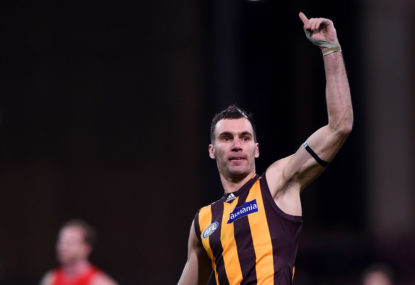The Hawthorn story continues to inexorably roll along, seven wins in a row seeing them a game clear on top of the ladder, and two games clear of fourth. The sense of impending doom has gripped all non-Hawks supporters.
Irrespective of whether their form is questionable, they are in a dominant position from which to mount their continued quest for a fourth consecutive premiership, even if I wrote them off four weeks ago.
I can assure you, Hawk fans have continued to remind me of it as each win is accumulated!
But, how did they orchestrate the last-gasp victory against Sydney? It’s as much about what the Swans did wrong as what the Hawks did right. Let’s dissect the crucial, match-winning play.
The first still below is taken just as the boundary umpire is about to launch the ball towards the ruckman. Hawthorn are kicking to the right, Sydney to the left.
Two players are letting the Swans down here, Jake Lloyd (44) and George Hewett (29).
We can see on the left that Isaac Smith (16) is Hawthorn’s spare player close the contest, in a much more dangerous position than Hewett in the foreground, who appears to be wondering whether or not he should push over to Josh Gibson on the far left, rather than focussing on what he should be doing – getting an extra number at the contest to force another stoppage.
Hewett should be directing Dan Hannebery (4) to push into the contest to surround Sam Mitchell (the most dangerous stoppage player in the AFL), with Hewett pushing to cover Taylor Duryea (8) himself. Hewett should also be letting Josh Kennedy, currently manning Mitchell, know that Isaac Smith is approaching the contest behind him.
Jake Lloyd is committing two cardinal sins by not being either closer to Jordan Lewis (3), or goal-side of him. Lewis is a renowned third-up specialist, with the second most hit-outs of any standard-sized midfielder in the competition (Ollie Wines is number one). Lloyd here is allowing him a free run to be third-up.

And if Lewis was to win the ball instead of hitting it out, Lloyd is in no position to stop him, especially given Lewis is a left footer and is likely to run toward the boundary, where there is plenty of space and he can freely swing onto his left, with Shaun Burgoyne in a position to shepherd Kieren Jack as you can see on the right.
This is a lack of football intelligence from Lloyd.
Here we see the continuation of Lloyd allowing Lewis to launch third-up, but also Josh Kennedy allowing Sam Mitchell to separate from him. Kennedy is in a tricky position here though, if he is aware of Smith behind him. If he covers Mitchell, he opens up the space for Smith. If he stays where he is, which is what he chooses, Mitchell gets a free run at the ball. All because Hewett and Hannebery weren’t more aware in the first place.

We can see below that Lewis has won the hit out, with Sam Mitchell having a free run to the drop zone. Jake Lloyd is caught in no man’s land – having not been able to stop Lewis, he is also in no position to prevent Mitchell.
If Hewett had done the right thing before the throw in, he would be covering Duryea here, with Hannebery in at the drop zone with Mitchell. Instead, we can see Hewett in the foreground doing nothing. Isaac Smith is now ostensibly Josh Kennedy’s responsibility.

Here we see Mitchell swinging his left boot and connecting a volley to send it 40 metres forward, straight down the line. Now, this is a superb act of skill from Mitchell, but there must be an element of luck involved. The Hawks claim to have trained this type of thing, but this ball could also have gone out on the full, or dribbled off the side of the boot into Kieren Jack’s path.
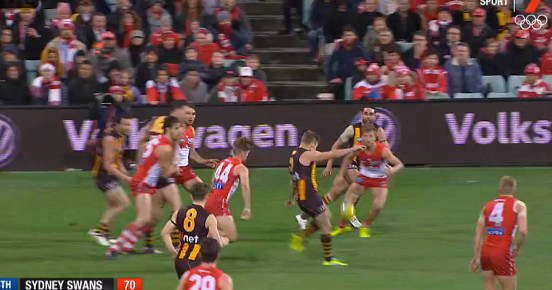
The ball is in flight, towards Jack Gunston and Dane Rampe. The Swans have good coverage, with all players goal-side of their opponent. Jarrad McVeigh is in the best position to win the ball, and Callum Mills is best placed to support, with Heath Grundy also in a good position to break clear of James Sicily and receive the ball.
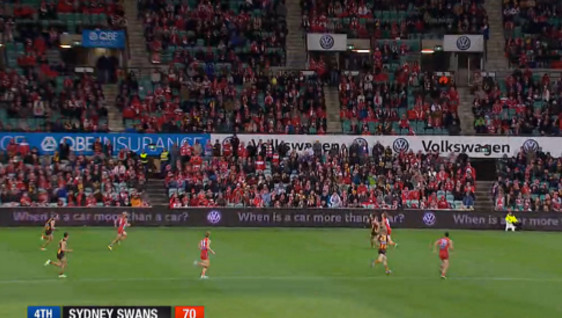
Gunston doesn’t mark the ball, but it fortuitously bounces off his right foot onto his left thigh before ricocheting into his running path, and away from McVeigh.

Gunston also maintains his strength in the contest, while Rampe loses his balance.
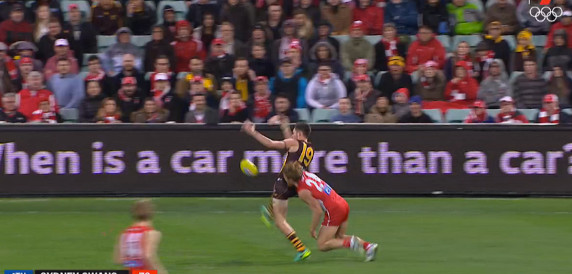


Remember Isaac Smith, who was left alone at the initial stoppage? Here he is accepting the ball off Gunston, having covered the most territory of any player who was at that boundary throw-in. Josh Kennedy, who should have taken responsibility for him from that point on, is nowhere to be seen. Kennedy doesn’t have Smith’s running capacity, but should have been thereabouts to put pressure on.
Kieren Jack was the other player who had a chance to pick up Smith on the way through, but Shaun Burgoyne worked harder than Jack to get there first, and can now block for his teammate, as he is doing.
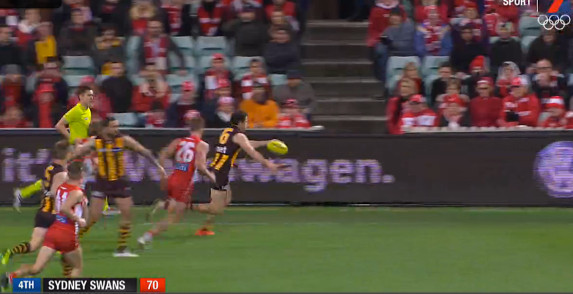
Smith sends a shanked tumbler forward. If he kicks a penetrating drop punt as he usually does, Nick Smith (40) is actually in a better position to mark the ball than Cyril Rioli (33), or at least force a neutral contest. Gary Rohan, seen on the right hand side slipping over, would also have been in a better position to win or neutralise the ball.
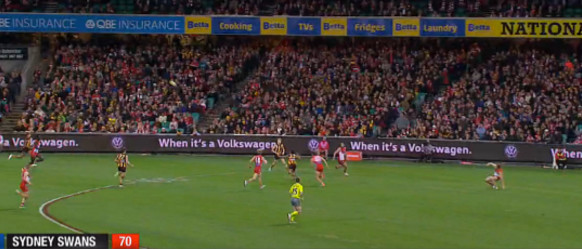
Cyril marks the ball and the rest, as they say, is history.

There are a few things to note about the above passage of play, which takes place in about 13 or 14 seconds of real time.
Firstly, Lewis only came up with the idea to flick the ball over the Mitchell as they approached the stoppage, and they gave each other a nod and a wink. So much for exhaustive planning and strategies taking place over the summer months for this very situation. This isn’t the NFL. Most of what happens on the football field is made up on the spot.
Secondly, this was not a victory that relies purely upon Hawthorn’s experience and skill. That’s a minor part. Sydney’s poor set-up and lack of smarts plays a bigger role. Luck is the most defining factor.
There were over 100 stoppages in this game. Hawthorn didn’t kick 100 goals. These type of plays are attempted every time and fail far, far, far more than they succeed.
There is no art to winning close matches, as this excellent post from Hurling People Now breaks down for us.
It was the Hawks’ good fortune that Hewett was in the vicinity of the stoppage instead of say the more experienced Luke Parker or Jarrad McVeigh, who may have acted more decisively and with more wits.
Sam Mitchell’s flung left boot connecting perfectly. The ball bobbling off Gunston’s body parts into the right channel for him to run onto. Smith’s shanked kick was a blessing, but would usually be a curse.
All of these events conspire to create the play that ended with the ball in Rioli’s hands. And he was able to deliver under extreme pressure, as Burgoyne did before him earlier in the quarter, consummating his best on ground performance.
But what about some credit to Hawthorn, I hear you ask. And you’re right, they certainly deserve it.
As stated earlier, Lewis is probably the best third-man up at stoppages in the league, so it’s a skill he has honed. Mitchell’s instincts and skill on either side of the body is renowned, which he put to perfect use.
Smith and Burgyone worked harder than their opponents. Gunston and Rioli were in front of their opponents, which is usually the percentage play in any situation.
These Hawks worked harder and smarter for longer than their counterparts. And it was to Hawthorn’s credit that they were in the contest to begin with, which is a simple but overlooked fact. You can’t win if you’re not there. That play is a lot less significant if they were seven points down instead of one.
As Ben Hogan said, “Golf is a game of luck. The harder I work, the luckier I get.” The same can be applied to Hawthorn. Yes, they are getting the breaks at the right time in their close matches, most of which are outside their control.
But the Hawks are doing the things they can control better than the opposition in these tight finishes. In each individual circumstance, luck and good fortune is playing a large role, but it is up to them to maximise it, which they’ve done.
Can it continue? Personally, I don’t think it will, and they are not playing well enough across four quarters to sustain they type of football that wins premierships. But it is still a pleasure to watch their champions go about their business, and try to lift the team over the line under pressure.





























































































